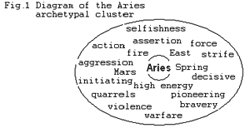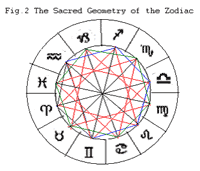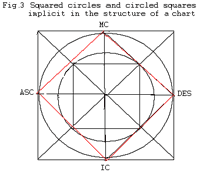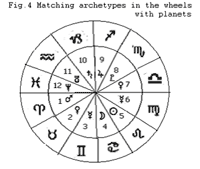AN ARCHETYPAL VIEW OF THE HOUSES
‘Everything breathes together’ (Plotinus)
The paradigm shift, announced by the Uranus-Neptune conjunction of 1992-3, and emerging strongly during the present Uranus-Neptune mutual reception, is bringing in a new way of seeing reality. James Lovelock’s Gaia theory1 that presents the earth as an alive and conscious organism is gaining in popularity, and changing not only how we see the planet but how we see the universe. Also, systems science has revealed fractal correspondence on different levels of scale in both the material and non-material worlds, and the findings of quantum physics support a vision of existence as one interconnected whole, with all things arising from the common ground of the quantum flow. It has also discovered that particles, even when separate and at a distance from each other, remain connected and in communication.
So we are beginning to entertain the notion of the universe as an alive and conscious organism. If this were the case, correspondences between the movements of stars and planets in the macrocosm and events in the human microcosm would be feasible, as these are then simply two levels on which the whole expresses an intention. This perspective brings a fresh understanding of the maxim ‘as above so below‘ on which astrology is based, and provides a context in which the phenomenon of synchronicity may be explained.
C.G.Jung was the first to systematically investigate synchronicity, defining it as “a coincidence in time of two or more causally unrelated events, which have the same or a similar meaning”2. His work in this field, together with his exposition of the archetypes, has been seminal to the new paradigm. In his later writings Jung went beyond seeing archetypes as projections of the human psyche to describe them as formative ideas within the collective mind. He saw them as the foundational principles of order in the cosmos, similar to the Greek ‘divine archai’ underlying flux and diversity. As such they govern both our inner life and events in the outer world, thus linking these two levels. “Our psyche is set up in accord with the structure of the universe, and what happens in the macrocosm likewise happens in the most subjective reaches of the psyche.”3
In his groundbreaking book Cosmos and Psyche4, Richard Tarnas uses data from thirty years of research to demonstrate how the archetypes unfold across the centuries to mould human history. He speaks of an ‘ensouled’ universe, indicating that his experience of astrology has led him to see the universe not only as intelligent and rational, but also as having a soul in the sense of an inner life, imagination and creative purpose. The archetypes are presented in Cosmos and Psyche as nodal centres in the universal or collective psyche around which complexes of themes cluster as if held by a magnet. For example the archetype we call Aries is the centre of a constellation of ideas and behaviour patterns as shown in Fig. 1. Cosmos and Psyche demonstrates scientifically that the archetypes are embedded in the vast cosmic processes that govern human life, and pattern evolution on a cosmic scale. They are like foundational ideas being worked out in the universal mind, and the fluid way their subsidiary ideas associate and merge with each other resembles quantum wave patterns interpenetrating in the quantum flow. Thus the archetypes we work with in astrology, seen from a transpersonal, psychological viewpoint, are living universal presences rather than abstract concepts. Dynamic rather than static, and more like verbs than nouns, they manifest in a process of ever-changing combinations.

Twelve Rays of the Infinite
In esoteric teaching the twelve archetypes represented by the zodiac are described as rays of the infinite, cosmic energies that manifest throughout the whole of creation. They express in astrology on three levels – the level of the signs, the level of the planets and the level of the houses. This third level of expression has not been generally recognised by astrologers, which this article seeks to rectify by proving that both houses and signs derive from the same sacred geometry, and are expressions of the same twelve archetypes. The archetypes are numinous, ineffable essences symbolised by the glyphs of the zodiac. Therefore, although they manifest in the signs, they are not the same thing as the 30-degree sections of the ecliptic of the tropical zodiac, or the twelve constellations of stars bearing the same names.
Many astrologers, including Richard Tarnas, speak of the planets as archetypes, but a distinction should be made here. Just as Plato would distinguish between the Idea of beauty and its personification as Aphrodite, so we should distinguish between the twelve foundational essences and the planets that are their spokesmen or representatives. Several planets can carry different facets of the same archetype- for example Saturn and Uranus both represent facets of the archetype Aquarius - and planets can also incorporate facets of more than one archetype together. For example, Chiron who is believed to have come in to the middle reaches of the solar system from the outer Kuiper belt, crossing in turn the paths of Pluto, Neptune and Uranus, seems to have incorporated facets of the archetypes corresponding to these planets, namely Scorpio, Pisces and Aquarius. When the relationship between planets and archetypes is seen in this way, new planets can be included in the astrological system without the need to find new archetypes for them.
The Sacred Geometry of the Zodiac
Zodiacs appear in diverse cultures all over the world, and, although different animal symbols are used on different continents, their number is always twelve as this is the number of the primary archetypes. The circle of the zodiac presents the archetypes in their ideal, eternal relationship. Its geometry is absolute in the sense that it is the alpha and omega state of the patterns that form and dissolve in the flux of time. Studying its structure helps us understand how the archetypes relate to one another on the levels of the houses and the planets.
The archetypes are polarised in the wheel in pairs of opposite principles, and the signs lying opposite each other, such as Cancer and Capricorn, are like the positive and negative poles of a magnet, linked by a strong current of energy flowing between them. Each polarised pair is at energetic loggerheads with the pair of archetypes lying at 90 degrees angle to it. Thus Cancer and Capricorn are linked in this strained way with Aries and Libra to form a cardinal square. Single archetypes are also connected energetically with those lying 120 degrees away from them round the circle to form equilateral triangles - for example Taurus is in a triangular relationship with Virgo and Capricorn, forming the earth trine. They also connect with those archetypes lying 60 degrees away on either side to form smaller isosceles triangles. For example Taurus, Cancer and Pisces are connected in this way. When the angles they make with each other are of 120 and 60 degrees, the energy along their lines of connection flows easily and harmoniously.
Thus the circle of the zodiac contains three central squares, four central triangles and twelve smaller triangles round its periphery. We call the lines linking the sections of the zodiac to form these geometric figures ‘aspects’. Fig. 2, showing the geometry of the main aspects, is also an image of the absolute relationships of the archetypes within the universe. The geometric patterns it contains manifest in the geometry of natural forms such as flowers and crystals, and permeate the individual psyche as well as structuring the cycles of time.

To study astrology is to study geometry in motion. While the archetypes remain in the absolute order shown in the zodiac circle, a succession of varying relationships form between them and dissolve again through the motion of their carriers - the planets. These move round the wheel in cycles, linking the archetypes represented by the signs and houses in different ways and for different lengths of time, to produce new compounded fields of meaning. For example, as Mars carries the spark of the Aries archetype when he enters a house or sign the meanings and associations of Aries (as in Fig 1) meld with the associations of the archetypes governing that house or sign. For example, if Mars is in Cancer and in the sixth house, the fields of meaning of Aries, Cancer and Virgo merge to produce a combined significance.
Where Earth meets Sky
Time and space are brought together in the modern western method of drawing a horoscope with two wheels. If it is a birth chart, it is the time and place of the native’s birth that determines the alignment of the wheels. The figure of the squared circle is fundamental to the horoscope diagram. The circle stands for the eternal sky - the home of the gods - while the square stands for incarnation and earthly life. Producing the calculations needed to exactly square a circle was the mathematical challenge for ancient geometers, and seen as tantamount to discovering the sacred mystery of the relationship between earth and heaven. In Tibetan mandalas, used in meditation to induce exalted states of consciousness, the squared circle appears as a basic figure, and it also appears in the ground plans of ancient temples and Neolithic sacred sites such as Stonehenge.6

Fig. 3 shows the geometric pattern of squared circles and circled squares on which a horoscope map is based. The central cross with its perpendicular and horizontal arms corresponds to the angles and the cardinal directions. They cut the outer circle at the points where circle and outer square meet. These are mystical points that symbolise the sacred union of earth and heaven, which explains why we experience the cusps of the cardinal houses as power points. When ASC, MC, DES and IC are joined to form a square, it touches the inner circle at four more points lying on the diagonal cross. The lines of this cross, that run through the middle of the four fixed houses, end in the corners of the outer square that act like tent pegs, anchoring the fixed energy. These points, as we will see, are also power points.
The modern western method of drawing a horoscope uses two wheels, which correspond to the outer and inner circles in Fig. 3. Each quadrant of each wheel is further divided into three sections. On the outer circle the twelve sections stands for twelve different areas of the sky. On the inner circle of the earth the sections represents different compass directions and times of day. The wheels mirror each other in that they are governed by same the twelve primary archetypes.
Thus the inner wheel brings the energies of the outer wheel literally down to earth, to ground them in local space and time, and to provide a setting in which the circulating planets express. Horoscopes can also be drawn as squares, thus emphasising the earth, or as single circles that emphasise the sky, but the two-wheeled diagram is superior to both, as it mirrors our experience of a static earth with a circular horizon, surrounded by a sky that, like a wheel, turns once around us in twenty-four hours.
Only when the inner wheel is drawn with equal houses measured from the ascendant, or using whole sign houses, do both wheels manifest the same archetypal geometry. When unequal house systems are used, the essential equality of the archetypes and their symmetry within the wheel is lost. Like the tropical zodiac, the equal house and whole sign house systems are based on the perfect and absolute archetypal geometry underlying all variations. However, this is not to claim that only these house systems are valid. Unequal houses are true representations of ephemeral geophysical and temporal conditions that come into being as stages within the diurnal cycle. And therefore charts that are erected, for example with Placidus houses, can be seen as ‘stills’ in the film of time, and as such they also have validity.
Fig. 4 shows the natural zodiac - the ideal alignment of the wheels, which is only reached once in twenty-four hours, when 0-degrees Aries on the ecliptic aligns with the first degree of the first house. Then the archetypes represented on both wheels correspond and the absolute state is reached. At all other times there is disparity. But the changing alignment of the wheels allows a variety of archetypal combinations to form, providing the diversity that becomes the basis for different personality types. And just as the perfection of the natural zodiac is only reached at one moment in twenty-four hours, so once in 24,000 plus years perfection is attained in the precessional cycle. Then the constellations are aligned with the sections of the ecliptic whose names they bear, and the tropical and sidereal zodiacs coincide. These examples show that there is an absolute state that reflects the geometric patterns behind temporal phenomena in their perfection, and ephemeral versions that come and go, and these are our normal experience in the world of time.

The Gods of the North, South, East and West
Our ancestors who built the pyramids and Stonehenge had a sense of the qualitative differences of the directions, inherited from their hunter-gatherer forbears, and their cultures were embedded in mythologies in which each direction had a different significance. In ancient China the southwest city gate was called the gate of man, the southeast the gate of earth, the northwest the gate of heaven, and the northeast the gate of ghosts and the ancestors. These quarter-directions are associated symbolically with the sunrise and sunset positions of the sun at the winter and summer solstices.
The east was ruled in Hindu mythology by Indra the god of war – a clear personification of the Aries archetype. This direction was always recognised as the source of great power, which explains the strong contribution our rising sign makes to our life and personality. Although the sun only rises due east at the equinoxes, the east is associated symbolically with the rising sun, and with it birth and spiritual rebirth. Thus Christian churches like Hindu temples face east, and Greek temples are aligned along the east-west axis. However, on all latitudes other than that of the equator the sun rises at progressive points that lie either north or south of due east. And the cycle of the sunrise points in relation to the horizon is another example of a cycle in which a state of perfection is repeatedly lost and then regained, this time within the course of six months.
In contrast, the west where the sun sets is associated in many cultures with death. In Thebes the necropolis together with the Valley of the Kings is situated on the west bank of the Nile. In Hindu mythology the west was ruled by Varuna, the god of water, who would seize wrongdoers and pluck them from the world of the living into his death-kingdom – a possible personification of the Scorpio archetype. In the wheel of the houses this archetype rules the eighth house, which lies to the northwest when a horoscope is drawn facing north instead of south - which has historical feasibility7.
When the horoscope is erected facing north, the northeast coincides with the eleventh house, governed by the Aquarius archetype and traditionally the house of the ‘good spirits’, which could be interpreted as friendly ancestors. The northeast orientation of the main entrance to the Stonehenge circle has been seen as proving that feasts of the dead involving ancestor worship were celebrated there. But the north was viewed by the Chinese as a source of unfavourable influences, and in many countries north-south routes are seen as ghost paths. In the Middle Ages the north doors of Christian churches were bricked up to prevent evil spirits from entering.
These examples show how the archetypes have been personified as the gods of the different directions, and have influenced the meanings ascribed to the directions in different cultures. It is also possible that these meanings have passed down into the signification of the astrological houses.
Power Points in Time
In ancient Egyptian mythology, sky and earth were represented as the lovers Nut and Geb, who had been torn apart and were seeking to reunite. The realm of Nut is the sky, represented by the outer wheel of the horoscope, and that of Geb is the earth, represented by the inner wheel. Where heaven and earth meet (the intersection points of the squared circle that correspond to the solstices and equinoxes) Nut and Geb symbolically copulate, and there is an energy exchange between earth and sky. In ancient cultures these points in the year were known as seasons of efficacy and marked with festivals, so that the whole community could benefit from them.
In its early history, the Delphic oracle was believed to be active only once a year, when streams of magnetic current flowed accompanied by manifestations of spirit. Similarly all sacred sites had their times when they were ‘live’, and it was the work of the astrologer-priests to calculate when they would be ‘plugged in’. These used their knowledge of astronomy to create calendars, the simplest of which were solar based. The astrologer would note the points where the sun rose and set on specific days of the year, and landscape features along the local horizon were used to mark these points, or standing stones were erected so alignments could be created to them.

The Celts celebrated eight festivals during the year - at the solstices and equinoxes, when outer square and circle align - and also at the mid-season quarter-days, when the inner circle and square align (Fig. 5). These festivals were integrated into the Christian calendar as the eight high points of the year. Thus the horoscope can be seen as a calendar marking the seasons of efficacy as well as map showing the directions radiating from a central site within a landscape. Behind each pagan festival lies the respective archetype that is activated at that season. Also, the traditional meanings of the feast days, like the meanings associated with the compass directions, have fed into our signification of the astrological houses.
Conclusion
Archetypes are the divine absolutes ordering the cosmos and underlying the flux and diversity of life. Like geometric forms they are transcendent to empirical reality yet give it form and meaning. They pattern time and space, and their order and fields of meaning extend through every level of the universe, permeating both the microcosm of the human psyche as well as the macrocosm around us. Astrology presents a beautiful, lucid, 3-D geometry of archetypal forms and forces in motion, showing how they meet and merge to create patterns of meaning within great interlocking time cycles. There is, however, nothing mechanical about this archetypal interaction, as the universe is not a machine but a living organism. Because our consciousness is part of its consciousness, and our will contributes to the will of the whole, we are able to affect what comes to pass. For this reason astrology should not be seen as concretely predictive but, as Richard Tarnas puts it, as archetypally predictive. And we should never forget our role as co-creators in the great evolutionary process of creation.
1 For example, James Lovelock Gaia and the Theory of the Living Planet (Gaia Books 2005)
2 C.G.Jung Synchronicity – An Acausal Connecting Principle (London:RKP 1972)
3 C.G.Jung Memories,Dreams, Reflections ( MDR 1963)
4 Richard Tarnas Cosmos and Psyche (Viking 2006)
6 John Michell. The Earth Spirit (Avon Books, 1975)
7 Phoebe Wyss The Spin of the Wheel Astrological Association Journal 49/1 January/February 2007
Phoebe Wyss March 2007











